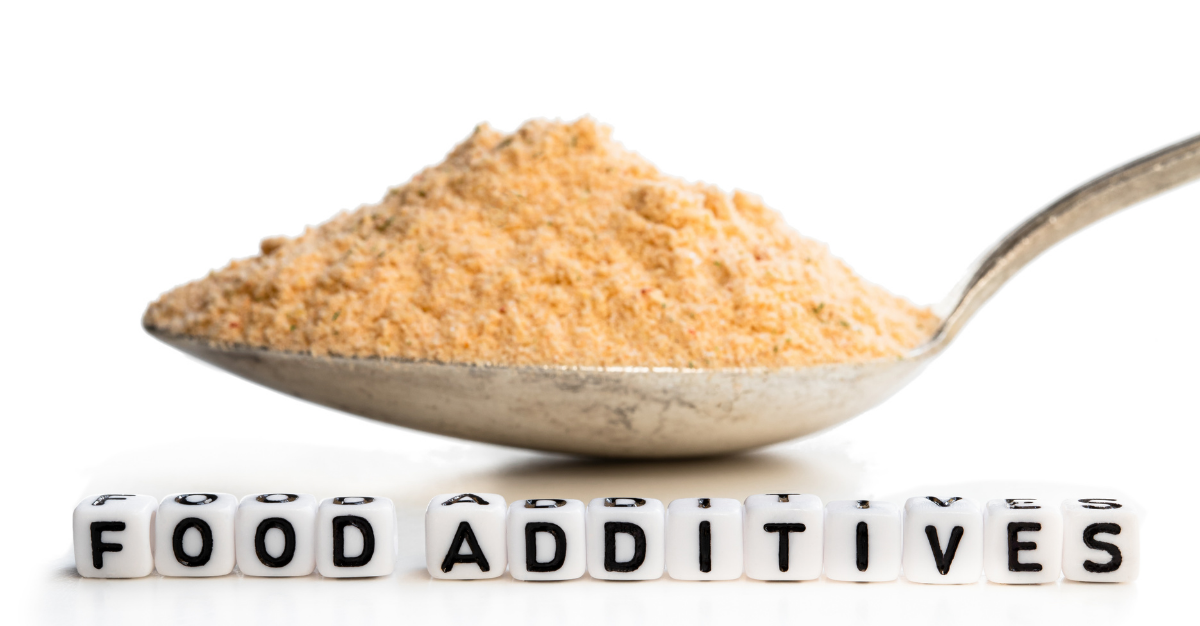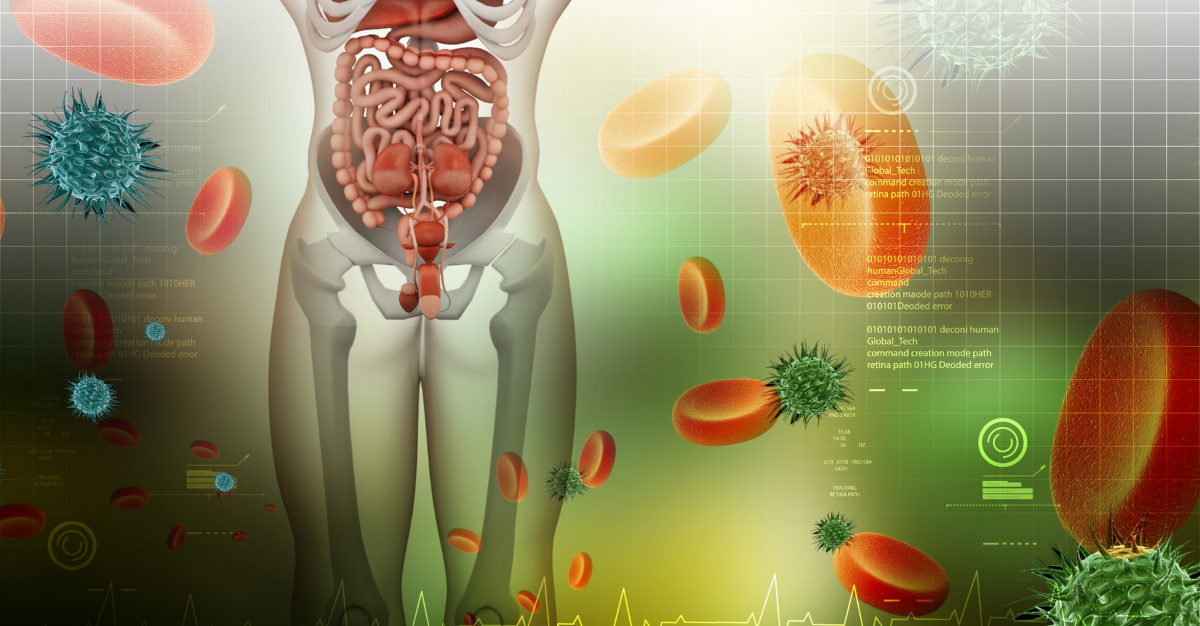
Think about any item in your kitchen pantry, flip over to the ingredients list and odds are…you’re going to find some kind of food additive!
Food additives are typically added to enhance the flavor, appearance, or texture of a product, or to extend its shelf life. Although generally tested for their safety, studies show that some of these substances have been associated with adverse health effects and should be avoided, while others are safe and can be consumed with minimal risk.
Even the healthiest eaters and most careful label-readers find it difficult to completely avoid food additives. Many foods that are considered healthy choices, such as many paleo-friendly or gluten-free foods, contain some kind of additives.
This can create a lot of confusion, such as: If cow’s milk contains no additives, is it a better choice than something like almond milk, which often contains the additive carrageenan? Or, is a dietary supplement with soy lecithin actually harming your health?
In this blog entry, we’ll take a look at some of the common food additives you can run into, and consider the pros and cons for each.
Emulsifiers
Soy lecithin
Soy lecithin is commonly found in dietary supplements, chocolate, ice cream, and some breads. Its purpose is to act as an emulsifier helping ingredients that don’t typically blend, such as oil and water, to combine together. Emulsifiers also reduce stickiness, control crystallization and prevent separation.
Soy lecithin is extracted from raw soybeans, and many people choose to avoid soy products. One reason for this is that soy is a common allergen, which is triggered by soy protein. However, the amount of soy lecithin in foods is typically very small, and the amount of soy protein is even smaller, so people with soy allergies don’t usually experience adverse effects. Of course, any reaction will depend on the severity of your allergy, so always proceed with caution if you have a soy allergy, and discuss the use of soy lecithin with a healthcare practitioner. Many people also chose to avoid soy products because they contain phytoestrogens, which can increase estrogen levels. Studies confirm that soy lecithin does contain high amounts of phytoestrogens, but, again, the amounts of soy lecithin used are extremely small, so the possible impact is low.
There are some possible health benefits to soy lecithin, as studies have found that it can reduce cholesterol levels. It’s also a source of choline, a nutrient that supports brain and liver function and heart health.
People with extreme soy allergies may want to avoid soy lecithin, but, for the rest of us, the amounts are so small that any risk is low. Anyone who has concerns about genetically modified soy may want to look for organic soy lecithin, but keep in mind that the amount – and any risk – is low.
Carrageenan
Carrageenan is typically found in almond milk, coconut milk, some meats, and some yogurts. Carrageenan acts as an emulsifier and thickening agent.
Some studies on animals found a connection between carrageenan intake and gastrointestinal issues, including cancerous colon lesions. More studies need to be done regarding any impact on human health, particularly since the levels of the additive used in the animal studies didn’t mirror typical human consumption. However, some in-vitro studies did find a link between certain kinds of intestinal inflammation and carrageenan consumption. These studies raised enough concern that the National Organic Standards Board has removed carrageenan from its list of approved ingredients.
Until more thorough research is completed, this is one additive to limit when possible. Fortunately, it’s possible to buy almond milk, coconut milk, and yogurt that doesn’t contain carrageenan. You can also make your own!
Flavor and Color Enhancers
Monosodium glutamate
Monosodium glutamate, or MSG, is added to enhance the flavor of many processed foods, canned soups, frozen meals and is commonly found in fast food and prepared meals at restaurants. MSG has been a subject of controversy for many years – from its effects on brain health to weight gain and metabolic syndrome – studies have shown it to have some negative effects on those that are sensitive to the additive. It has also been linked to headaches and sweating when consumed in large amounts.
Although research is still ongoing on the definitive effects of MSG on the body, if you experience any of the negative side effects mentioned it’s best to avoid MSG whenever possible.
Artificial food coloring
Artificial food coloring is used to brighten the appearance of everything from candy to condiments. There have been concerns about the negative effects of food coloring in recent years, specifically Blue 1, Red 40, Yellow 5 and Yellow 6. These dyes have been associated with allergic reactions and hyperactivity in children. In recent studies, Red 3 has been associated with increased risk of thyroid tumours in mice.
More and more studies show that food dyes may have negative effects on health so it’s best to avoid them as much as possible.
Artificial sweeteners
Common artificial sweeteners include aspartame, sucralose, saccharin and acesulfame potassium. These sweeteners can be found in many diet or low calorie foods as a flavor enhancer with little to no caloric content.
While this might sound great in theory and may benefit those who need to monitor blood sugar levels, artificial sweeteners have been linked in animal studies to cause weight gain, brain tumors, bladder cancer and many other health hazards. Those that are sensitive to artificial sweeteners typically experience headaches.
Although everyone has their unique individual needs, avoiding artificial sweeteners in favor of natural sweeteners such as raw honey, maple syrup or coconut sugar may be a better option.
Gums and Thickening Agents
Xanthan gum
Xanthan gum is commonly found in gluten-free baked goods. Xanthan gum acts as a thickener, stabilizer, or emulsifying agent.
Xanthan gum is produced when the Xanthomonas campestris bacterium ferments on a sugar, which creates a substance that can be dried and ground into a powder. Studies on humans have found that larger amounts (more than a typical diet would contain) of xanthan gum have a noted laxative effect, and can produce gas and other digestive activity. Other studies show a possible link between lower blood sugar levels and xanthan consumption, possibly because it slows sugar absorption.
People with sensitive digestive systems may want to limit their xanthan gum consumption. As well, anyone with severe corn, soy, wheat, or dairy allergies should confirm the product they use is free of any allergens, as those elements can be used in the fermentation process. Overall, however, this additive is largely safe for adults.
Guar gum
Guar gum is added to many processed foods, including salad dressings, sauces, some baked goods, and soups as a thickening agent.
Guar gum is a soluble fiber, and can increase the number of gut bacteria, with positive effects on constipation and irritable bowel syndrome. However, it can also lead to some digestive upset for people with sensitive systems. Guar gum can also lower blood sugar and cholesterol levels, and some studies show a potential positive effect on weight loss.
Anyone with digestive issues should monitor the effect guar gum has on their symptoms, since some people report an improvement after removing it from their diet. For most people, however, it’s a safe additive to consume.
Locust bean gum
Locust bean gum is a thickening agent added to many foods including dairy products such as ice cream, yogurt, and cheese.
Despite its name, this additive is actually derived from the carob tree. Studies haven’t found a lot of risk associated with locust bean gum consumption, and some evidence shows a positive effect on cholesterol levels.
As with guar gum, people with digestive issues might want to monitor their symptoms, since some people report increased gas and sensitivity, but this additive is considered safe
The Takeaway
Of course it’s ideal to avoid food additives altogether, but it may not always be realistic for everyone to prepare all food from scratch. The overall quality of your diet is far more important than how well you avoid these additives. Eating fewer packages and processed foods, more whole foods and cooking as much as possible is always recommended.
Try batch cooking and freezing meals so you always have options on hand, plan out your meals so that you head to the store with a list and spend a bit of time reading multiple labels of various products before you purchase.
Remember, your health and longevity are an investment! If you’d like to learn more about the foundations of a healthy diet and what to include and what to avoid, call us – we can create a health plan tailored to you and your individual needs!
Sources:
Mourad AM, de Carvalho Pincinato E, Mazzola PG, Sabha M, Moriel P. Influence of soy lecithin administration on hypercholesterolemia. Cholesterol. 2010;2010:824813. doi: 10.1155/2010/824813. Epub 2009 Dec 28. PMID: 21490917; PMCID: PMC3065734.
Maximilian Behr, Jörg Oehlmann, Martin Wagner,
Estrogens in the daily diet: In vitro analysis indicates that estrogenic activity is omnipresent in foodstuff and infant formula, Food and Chemical Toxicology,
Volume 49, Issue 10, 2011, Pages 2681-2688, ISSN 0278-6915,
https://doi.org/10.1016/j.fct.2011.07.039.
Awazuhara H, Kawai H, Baba M, Matsui T, Komiyama A. Antigenicity of the proteins in soy lecithin and soy oil in soybean allergy. Clin Exp Allergy. 1998 Dec;28(12):1559-64. doi: 10.1046/j.1365-2222.1998.00431.x. PMID: 10024228.
Tobacman JK. Review of harmful gastrointestinal effects of carrageenan in animal experiments. Environ Health Perspect. 2001;109(10):983-994. doi:10.1289/ehp.01109983
Food Safety News, “Board nixes use of carrageenan in organic food production” November 18, 2016.
Daly J, Tomlin J, Read NW. The effect of feeding xanthan gum on colonic function in man: correlation with in vitro determinants of bacterial breakdown. Br J Nutr. 1993 May;69(3):897-902. doi: 10.1079/bjn19930089. PMID: 8329363.
Osilesi O, Trout DL, Glover EE, Harper SM, Koh ET, Behall KM, O’Dorisio TM, Tartt J. Use of xanthan gum in dietary management of diabetes mellitus. Am J Clin Nutr. 1985 Oct;42(4):597-603. doi: 10.1093/ajcn/42.4.597. PMID: 4050722.
Fuwa, Masako & Nakanishi, Yukiko & Moritaka, Hatsue. (2016). Effect of Xanthan Gum on Blood Sugar Level after Cooked Rice Consumption. Food Science and Technology Research. 22. 117-126. 10.3136/fstr.22.117.
Russo L, Andreozzi P, Zito FP, et al. Partially hydrolyzed guar gum in the treatment of irritable bowel syndrome with constipation: effects of gender, age, and body mass index. Saudi J Gastroenterol. 2015;21(2):104-110. doi:10.4103/1319-3767.153835
Vuorinen-Markkola H, Sinisalo M, Koivisto VA. Guar gum in insulin-dependent diabetes: effects on glycemic control and serum lipoproteins. Am J Clin Nutr. 1992 Dec;56(6):1056-60. doi: 10.1093/ajcn/56.6.1056. PMID: 1442657.
Gunness P, Gidley MJ. Mechanisms underlying the cholesterol-lowering properties of soluble dietary fibre polysaccharides. Food Funct. 2010 Nov;1(2):149-55. doi: 10.1039/c0fo00080a. Epub 2010 Sep 30. PMID: 21776465.
Babiker, R., Merghani, T.H., Elmusharaf, K. et al. Effects of gum Arabic ingestion on body mass index and body fat percentage in healthy adult females: two-arm randomized, placebo controlled, double-blind trial. Nutr J 11, 111 (2012). https://doi.org/10.1186/1475-2891-11-111
Søndergaard, O. Meyer, G. Würtzen,Magnesium stearate given peroprally to rats. A short term study, Toxicology,Volume 17, Issue 1,1980, Pages 51-55,
ISSN 0300-483X,
https://doi.org/10.1016/0300-483X(80)90026-8.
National Center for Biotechnology Information (2021). PubChem Compound Summary for CID 11177, Magnesium stearate. Retrieved August 23, 2021 from https://pubchem.ncbi.nlm.nih.gov/compound/Magnesium-stearate.








